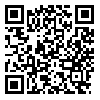Volume 21, Issue 3 (Autumn 2013)
Avicenna J Nurs Midwifery Care 2013, 21(3): 68-76 |
Back to browse issues page
Download citation:
BibTeX | RIS | EndNote | Medlars | ProCite | Reference Manager | RefWorks
Send citation to:



BibTeX | RIS | EndNote | Medlars | ProCite | Reference Manager | RefWorks
Send citation to:
Hazavehi M, Taheri M, Moeini B, Roshanaei G. Investigating causes of the infants’ growth disorder (6-12 months) in Hamadan health centers based on Health Belief Model . Avicenna J Nurs Midwifery Care 2013; 21 (3) :68-76
URL: http://nmj.umsha.ac.ir/article-1-1147-en.html
URL: http://nmj.umsha.ac.ir/article-1-1147-en.html
1- Hamadan University of Medical Sciences & Health Services
2- Hamadan University of Medical Sciences & Health Services ,Babak_moeini@umsha.ac.ir
2- Hamadan University of Medical Sciences & Health Services ,
Abstract: (21400 Views)
Background: Due to rapid transition from breast feeding to other food groups, failure to thrive is common among infants. The aim of this study was to determine the factors that cause failure to thrive in infants from 6 to 12 months based on Health Belief Model (HBM) in Hamadan.
Methods: In this cross sectional case-control study, 100 mothers of infants with growth disorders as case group members and 100 mothers of healthy infants as control group members were selected randomly from Hamadan health centers. The subjects’ performance was measured by a questionnaire, HBM's constructs and a check list. Data was analyzed by SPSS software 16.
Result: This study showed that birth rank (p =0.04) and family income (p=0.004) had direct relationships with growth disorder. The mean score of awareness about infants’ growth disorder in case group mothers was lower than control group members’ (P= 0.01). The study also demonstrated significant relationships between growth disorder and perceived severity (p=0.01), perceived benefits (p= 0.022) and self-efficacy (p= 0.01)
Conclusion: Based on this study, Family size, family income, mother's awareness about growth disorder, perceived severity, perceived benefits and self-efficacy are associated with growth disorder in infants. So, family planning intervention to control family size and educational intervention to increase mothers’ self-efficacy and awareness about preparing supplementary food for their infants are recommended.
Type of Study: Original Research |
Subject:
Nursing
Received: 2013/12/24 | Accepted: 2013/12/24 | Published: 2013/12/24
Received: 2013/12/24 | Accepted: 2013/12/24 | Published: 2013/12/24
Send email to the article author
| Rights and permissions | |
 |
This work is licensed under a Creative Commons Attribution-NonCommercial 4.0 International License. |





 gmail.com
gmail.com